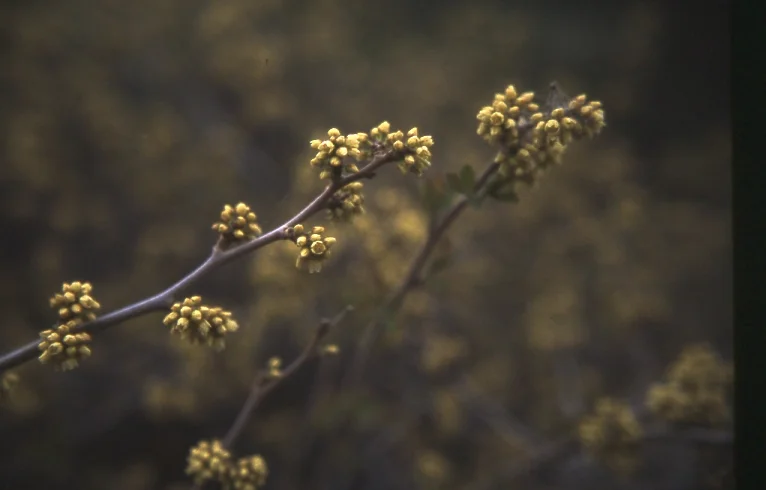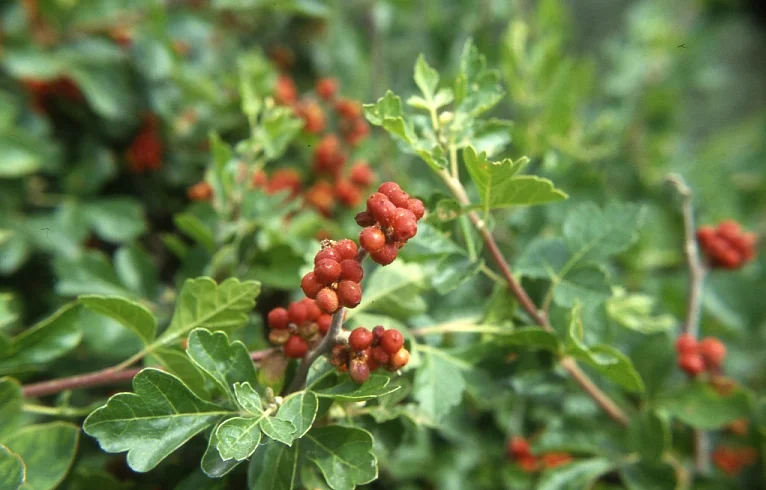Skunkbush
Ethnobotany
On south facing coulee slopes or river banks, this small shrub (1–2 meters high), has dense clusters of small yellow flowers at the end of its branches in May before any leaves appear. The flowers have a faint but unpleasant odour, hence the common name. The fruit that develops is an orange red-berry, 5–6 mm in diameter, lightly covered with sticky hairs.
The fruit is strongly acidic tasting, but Royer and Dickinson claim the berries “can be eaten raw or cooked and can serve as an emergency survival food in winter.” They also say the leaves were mixed with tobacco. (66)
Both Kershaw (79) and Hungry Wolf (6) report its use to make a black dye. The leaves were boiled to create the dye, and the wood ash was used to set the dye. Kershaw mentions other uses of the twigs. They were woven into sun shades or hats, or shaped into an owl that, when hung near the top of the tipi, would move with the flow of air. Mothers used this to scare their children into good behaviour—a type of First Nations boogieman. (79)
Johnston reports one desperate and futile use of Rhus trilobata by the Blackfoot: “The dried berries were ground and dusted on the pustules of smallpox....” (42)
Botany
Growth habit and range: This is a somewhat common shrub found on exposed, south-facing hillsides on the prairies, and stream banks in the southern half of the province. It is a heavily branched, spreading plant which grows to a height of 1–2 meters.
Description: The young bark is reddish and slightly hairy, and becomes greyish and smoother with age. The green leaves are alternate on the stems and measure up to 7 cm in length. The petiole is long and reddish coloured, and the under surface of the leaf is pale green in colour. The leaf is three-lobed, and displays a rounded to shallowly scalloped margin on each of the fan to wedge-shaped leaflets. The leaves have a faint scent which has been likened to that of a skunk by some, and lemonade by others. In autumn, the leaves turn purple to red.
The flowers are tiny and occur in terminal clusters near the tips of the branches before the leaves appear in spring (mid May). Each flower displays 5 yellowish petals, 5 united sepals and 5 stamens. The flowers too are malodorous. The fruit is a round, shiny red to orange berry-like drupe measuring 5–8 mm in length. Each fruit contains a single, flattened, yellowish seed measuring about 5mm in diameter.
References
Hungry Wolf, Adolf. 1989. Teachings of Nature. Good Medicine Books, BC.
Johnston, Alex. 1987. Plants and the Blackfoot. Occasional Paper No. 15., Lethbridge Historical Society, AB.
Kershaw, Linda. 2000. Edible and Medicinal Plants of the Rockies. Lone Pine Publishing, AB.
Royer, France and Richard Dickinson. 2007. Plants of Alberta. Lone Pine Publishing, AB.


